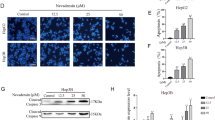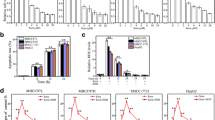Abstract
Hepatocellular carcinoma (HCC), the most prevalent kind of liver cancer, remains one of the world’s main causes of death. The alpha7 nicotinic acetylcholine receptor (α7nAchR) has been recognized to be overexpressed in malignancies and chemoresistance. Since little is known about the role of α7nAchR expression in drug-resistant cells, this study was designed to investigate the effect of α7nAchR suppression in combination with Sorafenib (SOR) on SOR-resistant HCC cells. First, SOR-resistant HCC cells were generated. To suppress the expression of α7nAchR, cells were treated with SOR following siRNA transfection. qRT-PCR was used to examine the expression of α7nAchR and apoptotic genes by evaluating the IC50 of SOR and the combination of α7nAchR siRNA and SOR on the survival of resistant cells. Moreover, apoptosis, autophagy, and cell cycle analysis for resistant HCC cells were performed using flow cytometry. Cell migration and colony formation assays were also used for further confirmation. Our results suggest that inhibiting α7nAchR can lead resistant HCC cells to become sensitive. Furthermore, when siRNA and SOR were treated together, HCC-resistant cells showed a considerable reduction in α7nAchR mRNA gene expression. In addition, when α7nAchR was downregulated in combination with SOR, migration and colony formation were inhibited. Apoptosis was triggered by modulating the expression of apoptotic target genes, and cell cycle arrest was observed in the G2-M and subG1 phases. Overexpression of α7nAchR in SOR-resistant HCC cells suggests that it might be a therapeutic target for HCC cell resistance therapy.










Similar content being viewed by others
References
Liu CY, Chen KF, Chen PJ. Treatment of liver cancer. Cold Spring Harb perspect med. 2015;5(9):a021535. https://doi.org/10.1101/cshperspect.a021535.
Bruix J, Tak WY, Gasbarrini A, et al. Regorafenib as second-line therapy for intermediate or advanced hepatocellular carcinoma: multicentre, open-label, phase II safety study. Eur J Cancer. 2013;49(16):3412–9. https://doi.org/10.1016/j.ejca.2013.05.028.
Zhu Y-J, Zheng B, Wang H-Y, Chen L. New knowledge of the mechanisms of sorafenib resistance in liver cancer. Acta Pharmacol Sin. 2017;38(5):614–22. https://doi.org/10.1038/aps.2017.5.
Wu SY, Lopez-Berestein G, Calin GA, Sood AK. RNAi Therapies: drugging the undruggable. Sci Transl Med. 2014;6(240):240ps7. https://doi.org/10.1126/scitranslmed.3008362.
Mansoori B, Sandoghchian Shotorbani S, Baradaran B. RNA interference and its role in cancer therapy. Adv Pharm Bull. 2014;4(4):313–21. https://doi.org/10.5681/apb.2014.046.
Hajiasgharzadeh K, Somi MH, Sadigh-Eteghad S, et al. The dual role of alpha7 nicotinic acetylcholine receptor in inflammation-associated gastrointestinal cancers. Heliyon. 2020;6(3):e03611–e03611. https://doi.org/10.1016/j.heliyon.2020.e03611.
Millar NS, Harkness PC. Assembly and trafficking of nicotinic acetylcholine receptors (Review). Mol Membr Biol. 2008;25(4):279–92. https://doi.org/10.1080/09687680802035675.
Hurst R, Rollema H, Bertrand D. Nicotinic acetylcholine receptors: from basic science to therapeutics. Pharmacol Ther. 2013;137(1):22–54. https://doi.org/10.1016/j.pharmthera.2012.08.012.
Hajiasgharzadeh K, Somi MH, Mansoori B, et al. Small interfering RNA targeting alpha7 nicotinic acetylcholine receptor sensitizes hepatocellular carcinoma cells to sorafenib. Life Sci. 2020;244:117332. https://doi.org/10.1016/j.lfs.2020.117332.
Ferlay J, Colombet M, Soerjomataram I, et al. Estimating the global cancer incidence and mortality in 2018: GLOBOCAN sources and methods. Int J Cancer. 2019;144(8):1941–53. https://doi.org/10.1002/ijc.31937.
Daher S, Massarwa M, Benson AA, Khoury T. Current and future treatment of hepatocellular carcinoma: an updated comprehensive review. J Clin Transl Hepatol. 2018;6(1):69–78. https://doi.org/10.14218/JCTH.2017.00031.
Filipits M. Mechanisms of cancer: multidrug resistance. Drug Discov Today Dis Mech. 2004;1(2):229–34. https://doi.org/10.1016/j.ddmec.2004.10.001.
Afrashteh Nour M, Hajiasgharzadeh K, Kheradmand F, et al. Nicotinic acetylcholine receptors in chemotherapeutic drugs resistance: an emerging targeting candidate. Life Sci. 2021;278:119557. https://doi.org/10.1016/j.lfs.2021.119557.
Le Grazie M, Biagini MR, Tarocchi M, Polvani S, Galli A. Chemotherapy for hepatocellular carcinoma: the present and the future. World J Hepatol. 2017;9(21):907–20. https://doi.org/10.4254/wjh.v9.i21.907.
Babu A, Munshi A, Ramesh R. Combinatorial therapeutic approaches with RNAi and anticancer drugs using nanodrug delivery systems. Drug Dev Ind Pharm. 2017;43(9):1391–401. https://doi.org/10.1080/03639045.2017.1313861.
Wang S, Hu Y. α7 nicotinic acetylcholine receptors in lung cancer. Oncol Lett. 2018;16(2):1375–82. https://doi.org/10.3892/ol.2018.8841.
Sun H-J, Jia Y-F, Ma X-L. Alpha5 nicotinic acetylcholine receptor contributes to nicotine-induced lung cancer development and progression. Front Pharmacol. 2017. https://doi.org/10.3389/fphar.2017.00573.
Huang L-C, Lin C-L, Qiu J-Z, et al. "Nicotinic acetylcholine receptor subtype alpha-9 mediates triple-negative breast cancers based on a spontaneous pulmonary metastasis mouse model. Front Cell Neurosci. 2017;11:336. https://doi.org/10.3389/fncel.2017.00336.
Nguyen HD, Liao Y-C, Ho Y-S, et al. The α9 nicotinic acetylcholine receptor mediates nicotine-induced PD-L1 expression and regulates melanoma cell proliferation and migration. Cancers (Basel). 2019;11(12):1991.
Tu CC, Huang CY, Cheng WL, et al. Silencing A7-nAChR levels increases the sensitivity of gastric cancer cells to ixabepilone treatment. Tumour Biol. 2016;37(7):9493–501. https://doi.org/10.1007/s13277-015-4751-x.
Tu CC, Huang CY, Cheng WL, et al. The α7-nicotinic acetylcholine receptor mediates the sensitivity of gastric cancer cells to taxanes. Tumour Biol. 2016;37(4):4421–8. https://doi.org/10.1007/s13277-015-4260-y.
Clarke MR, Jones B, Squires CLM, et al. Cyclic imine pinnatoxin G is cytotoxic to cancer cell lines via nicotinic acetylcholine receptor-driven classical apoptosis. J Nat Prod. 2021;84(7):2035–42. https://doi.org/10.1021/acs.jnatprod.1c00418.
Witayateeraporn W, Arunrungvichian K, Pothongsrisit S, et al. α7-Nicotinic acetylcholine receptor antagonist QND7 suppresses non-small cell lung cancer cell proliferation and migration via inhibition of Akt/mTOR signaling. Biochem Biophys Res Commun. 2020;521(4):977–83. https://doi.org/10.1016/j.bbrc.2019.11.018.
Hsu CC, Tsai KY, Su YF, et al. α7-Nicotine acetylcholine receptor mediated nicotine induced cell survival and cisplatin resistance in oral cancer. Arch Oral Biol. 2020;111: 104653. https://doi.org/10.1016/j.archoralbio.2020.104653.
Cingir Koker S, Jahja E, Shehwana H, Keskus AG, Konu O. Cholinergic Receptor Nicotinic Alpha 5 (CHRNA5) RNAi is associated with cell cycle inhibition, apoptosis, DNA damage response and drug sensitivity in breast cancer. PLoS ONE. 2018;13(12): e0208982. https://doi.org/10.1371/journal.pone.0208982.
Zhang C, Ding XP, Zhao QN, et al. Role of α7-nicotinic acetylcholine receptor in nicotine-induced invasion and epithelial-to-mesenchymal transition in human non-small cell lung cancer cells. Oncotarget. 2016;7(37):59199–208. https://doi.org/10.18632/oncotarget.10498.
Bu X, Zhang A, Chen Z, et al. Migration of gastric cancer is suppressed by recombinant Newcastle disease virus rL-RVG via regulating α7-nicotinic acetylcholine receptors/ERK- EMT. BMC Cancer. 2019;19(1):976. https://doi.org/10.1186/s12885-019-6225-9.
Nishioka T, Kim HS, Luo LY, et al. Sensitization of epithelial growth factor receptors by nicotine exposure to promote breast cancer cell growth. Breast Cancer Res. 2011;13(6):R113. https://doi.org/10.1186/bcr3055.
Author information
Authors and Affiliations
Corresponding authors
Ethics declarations
Conflict of interest
The authors declared that there is no conflict of interest related to this study.
Ethical approval
The present study was supported by Immunology Research Center, Tabriz University of Medical Sciences, Tabriz, Iran. R.UMSU.REC.1399.083
Informed consent
The data are available through direct contact with Mina Afrashteh Nour, Fatemeh Kheradmand, and Behzad Baradaran.
Additional information
Publisher's Note
Springer Nature remains neutral with regard to jurisdictional claims in published maps and institutional affiliations.
Rights and permissions
About this article
Cite this article
Nour, M.A., Kheradmand, F., Rasmi, Y. et al. Alpha7 nicotinic acetylcholine receptor expression in Sorafenib-resistant Hepatocellular carcinoma cells. Med Oncol 39, 165 (2022). https://doi.org/10.1007/s12032-022-01745-5
Received:
Accepted:
Published:
DOI: https://doi.org/10.1007/s12032-022-01745-5




